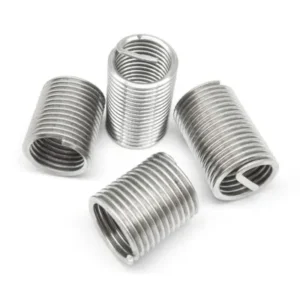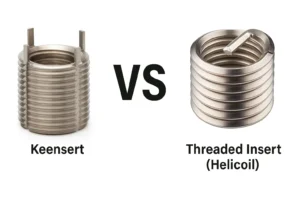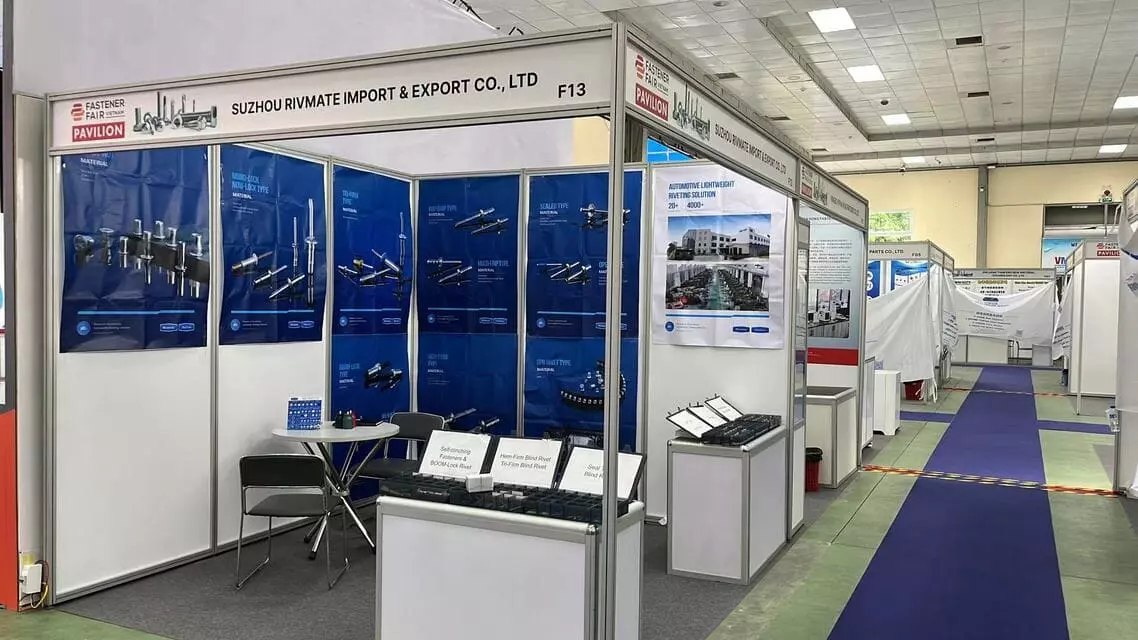Large Size, High Strength Rivet Nuts
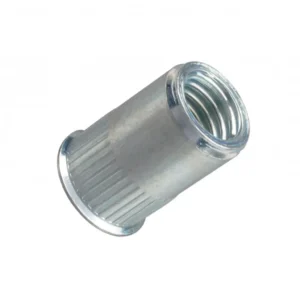
Leading Rivet Nut Manufacturer and Supplier in China

When it comes to securing components in heavy-duty machinery, construction equipment, or agricultural vehicles, strength and reliability are non-negotiable. That’s where high strength rivet nuts come into play. Designed to withstand extreme loads and harsh environments, these powerful fasteners are essential for ensuring structural integrity in the most demanding applications. In this blog, we’ll explore why large size, high strength rivet nuts are a must-have for heavy-duty fastening solutions.
Table of Contents
Why Do We Need Large Size, High Strength Rivet Nuts?
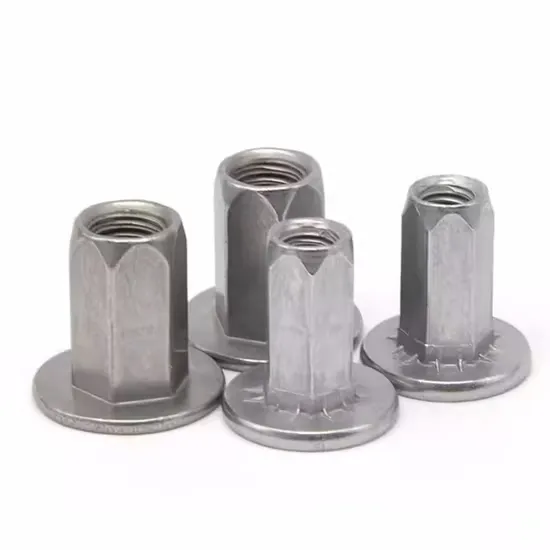
Rivet nuts are widely used fasteners for blind hole connections, commonly found in light to medium-strength applications such as furniture assembly, household appliance casings, automotive body structures, and fitness equipment. They are easy to install, compact in design, and provide stable fastening with single-sided operation, making them the “universal connection solution” in modern assembly processes.
However, when we turn our attention to large equipment and high-strength structural components, such as:
- Construction lifting platforms, steel framework
- Agricultural machinery like tractors and combine harvesters
- Construction machinery like bulldozers, dump trucks, and packaging equipment
These machines typically operate under high loads, high impact, high vibration, and even extreme temperature and humidity conditions. At this point, we must ask:
Can standard-sized and standard-strength rivet nuts still meet the demands of these working conditions?
The answer is no.
To meet the higher requirements for fasteners in these environments, large size, high strength rivet nuts have emerged. They not only come in larger sizes (common thread sizes can reach M16 or 3/4″), but are also made from high-strength steel and designed with thicker walls, offering pull-out forces and anti-rotation performance far beyond standard rivet nuts. These features make them an irreplaceable fastening core in heavy machinery and critical structural applications.
Typical Applications and Industries
1. Construction Equipment
In the construction industry, many equipment types need to operate steadily under high-altitude or heavy-load conditions, such as tower cranes, lifting platforms, and large steel structures. These structural components often endure significant shear forces and vibrations, demanding extremely high strength and anti-rotation performance from fasteners. Large size, high strength rivet nuts can be used in:
- Steel structure connections: Quick installation, replaceable, suitable for areas where welding is impractical or difficult to construct;
- Platform railings, operation handrails, and other auxiliary components: Improve safety and ease of maintenance.
2. Agricultural Machinery
Modern agricultural machinery, such as tractors, combine harvesters, and seeders, often operates in rugged terrain and harsh climates. The main framework and operational units must have excellent shock resistance and durability. Rivet nuts are used in:
- Component connections of the machine’s body frame, such as engine supports and pivot point fastenings;
- Hydraulic cylinder brackets, foot pedal platforms, and control box installation points.
3. Construction Vehicles and Mining Machinery
Heavy construction vehicles (such as bulldozers, dump trucks, and excavators) and mining equipment endure massive loads, intense vibrations, and frequent operations. Traditional welding or bolt connections can be inconvenient during some maintenance processes, whereas large size rivet nuts provide:
- High pull-out force and anti-rotation performance, suitable for applications like cabin frame supports, hydraulic system interfaces, and exterior panel fastenings;
- Blind installation characteristics that are beneficial in tight spaces, such as inside enclosures or the underside of vehicles.
4. Packaging and Heavy Automation Equipment
In industrial automation, equipment such as packaging machines, pallet conveyors, and stackers often require high load-bearing and continuous operation, making it crucial for the fasteners to be stable and reliable.
- Rivet nuts are used to install motor brackets, control panels, and cable ducts;
- Modular assembly with maintainable and replaceable parts is particularly important, as it helps reduce downtime and maintenance costs.
5. Wind Energy, Rail Transportation, and Ground Aerospace Equipment
Equipment in these sectors is often exposed to outdoor or extreme environments, requiring fasteners with corrosion resistance, fatigue resistance, and high strength.
- Wind turbine tower frames, nacelle covers, and cable support brackets use high-strength rivet nuts to improve structural stability;
- Rail vehicle chassis, battery module brackets, and aerospace ground handling equipment require high-reliability fasteners for secure connections.
What Are Large Size, High Strength Rivet Nuts?
Large size, high strength rivet nuts are structural fasteners designed for heavy-duty and harsh environments. They offer larger sizes and stronger mechanical performance compared to standard rivet nuts, and are widely used in industries such as construction machinery, rail transportation, wind energy, and heavy-duty equipment.
a. Large Size Definition
Typically, “large size” refers to rivet nuts with thread sizes significantly larger than standard rivet nuts. Common ranges include:
- Imperial sizes: 1/2-13, 5/8-11, 3/4-10, etc.;
- Metric sizes: M12, M14, M16, with some custom products reaching M20 or larger;
- Outer diameter, rivet length, and installation hole size are also increased accordingly.
Example: The installation hole diameter for an M16 hexagonal rivet nut typically needs to be between 22.0~22.2mm, with a rivet length that can exceed 30mm. This imposes higher requirements on tool clamping force and base material strength.
b. High Strength Features
1. Higher Material Performance
Large size rivet nuts are typically made from higher-grade metals to withstand larger loads:
- Grade 10.9 carbon steel: Tensile strength ≥ 1040 MPa;
- 304 / 316 stainless steel rivet nuts: Excellent corrosion resistance and moderate strength;
- Alloy steel: Used in high-temperature or extreme load scenarios.
2. Enhanced Structural Design
To improve strength and durability, these rivet nuts are optimized geometrically:
- Thicker wall design: The overall cross-section is thicker, improving tensile and shear strength;
- Extended rivet area: Provides a larger clamping area, allowing more uniform deformation and stronger rivet fastening;
- Full hexagonal/half hexagonal shapes: Mechanical anti-rotation is achieved by embedding the profile, preventing loosening in high-vibration conditions.
3. Superior Mechanical Performance
- Pull-out strength
- Unwinding torque
- Break torque
This indicates that high strength rivet nuts are not only safe and reliable under static loads, but also perform excellently under repeated impacts and dynamic loads.
c. Higher Tool and Process Requirements
Due to increased size and strength, higher demands are placed on installation tools:
- Greater installation torque: Requires hydraulic rivet nut guns, electric pull-out tools, or custom servo fixtures;
- Upgraded jaw strength: The jaws and screws need to have higher durability to withstand larger pulling forces;
- Tight preload control: Some high-strength rivet nuts require precise control of the pull-out stroke and preload force during assembly to ensure the rivet remains secure and does not shift after installation.
For M14, M16, or imperial 5/8″ and larger rivet nuts, it is recommended to use pneumatic-hydraulic rivet systems or industrial-grade electric installation equipment.
Do You Have Any Questions?
Let Us Solve Your Problem
What Are the Common Types and Designs?
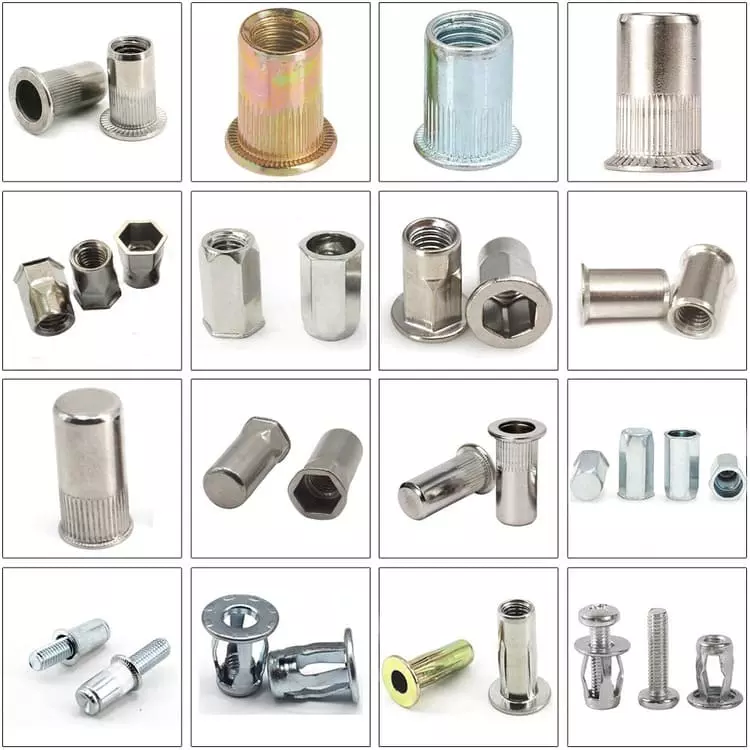
a. Round Body vs Hex Body
- Suitable for general installation scenarios, allowing for quick installation in pre-drilled round holes;
- Requires good clamping force and proper base material thickness to prevent rotation;
- Lower cost and widely used.
- The external shape is hexagonal, which enables strong anti-rotation when paired with hexagonal preformed holes;
- Particularly suitable for high torque, high vibration conditions, such as agricultural machinery, construction vehicles, and wind energy structures;
- It is the most common high-strength anti-rotation structure in large size rivet nuts.
Summary: If the application involves significant rotational or shear forces, it is recommended to prioritize the hex body design.
b. Open End vs Closed End
Open End/ Standard Rivet Nut
- Simple structure, with the screw passing through the entire rivet nut after installation;
- Suitable for conditions where sealing or dust protection is not required;
- Commonly used in mechanical housings, piping, and frame connections.
- The end is sealed, preventing liquid, dust, or gas penetration;
- Enhances corrosion resistance, often used in outdoor equipment or electronic and electrical enclosures with higher protection requirements;
- Also improves structural rigidity, and some closed-end models can withstand higher pull-out forces.
c. Reduced Head vs Countersunk Head
- The head size is smaller, suitable for scenarios with limited installation space or a need for low visibility;
- Load is concentrated during riveting, so base material strength and proper fit must be ensured;
- Common in household appliances, fitness equipment, and small metal structure connections.
- The head has a conical shape, which allows it to sit flush with the base material, providing a neater appearance and minimizing protrusion;
- During installation, the head embeds into the base material, helping to distribute stress and improve tensile strength;
- Often used in aluminum plates, stainless steel plates, or coated materials where countersinking is required.
Summary: For aesthetics and a smooth surface, choose countersunk heads; for tight spaces or thinner mounting surfaces, choose reduced heads.
d. Surface Treatment and Corrosion Resistance
| Surface Treatment | Features and Applicable Scenarios |
| Zinc Plated | Standard rust prevention treatment, suitable for indoor or light corrosion environments |
| Electrophoresis | Forms a black coating, providing rust protection and enhancing appearance, suitable for household appliances or tool products |
| Dacromet | High-grade corrosion-resistant treatment, with salt spray resistance exceeding 500 hours, suitable for seaside, wind energy, heavy industry environments |
| Stainless Steel (e.g., 304/316) | No additional surface treatment required, excellent corrosion resistance, suitable for medical, food, and outdoor equipment in high-standard applications |
How Do They Perform Compared to Standard Rivet Nuts?
| Performance Indicator | Standard Rivet Nuts | Large Size, High Strength Rivet Nuts |
| Thread Size Range | Typically M3–M10 or 6-32 to 3/8-16 | M12–M16, 1/2-13, 5/8-11, even 3/4-10, etc. |
| Pull-out Strength | Typically 1,000–8,000 lbs | Up to 20,000–35,000 lbs (e.g., Sherex LRGH) |
| Torque Resistance | Round body types are prone to rotation, torque limit around 20–80 ft-lbs | Hex body can reach 150–250+ ft-lbs, extremely strong anti-rotation performance |
| Material Strength | Common materials: Aluminum, low-carbon steel, stainless steel | High-strength steel, 10.9-grade alloy steel, stainless steel, nickel alloys, etc. |
| Structural Design | Standard wall thickness, short rivet area | Thickened walls, long riveting stroke, anti-rotation reinforced structure (e.g., full hex) |
| Applications | Household appliances, sheet metal, light industrial products | Heavy machinery, construction equipment, mining machinery, agricultural equipment |
| Installation Tool Requirements | Manual or pneumatic rivet guns are sufficient | Requires high-tensile hydraulic or electric tools, some models require specialized fixtures |
| Cost | Lower cost, suitable for large-scale general applications | Higher cost, but performance and reliability far superior to standard nuts |
How Are Large Rivet Nuts Installed?
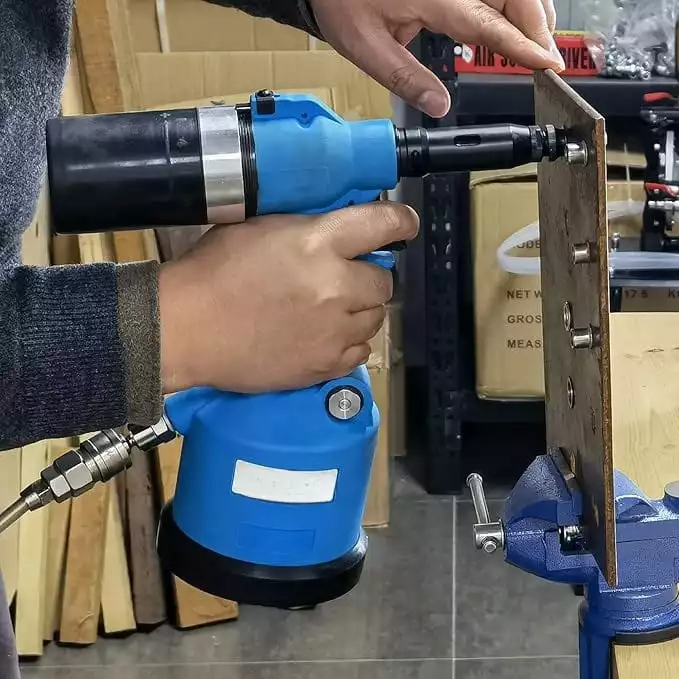
Selection of Installation Tools
a. Hydraulic Rivet Nut Tool
- Suitable for high-tensile, high-strength rivet nuts, providing stable riveting pressure, compatible with large thread sizes such as 5/8-11, 3/4-10.
- Suitable for medium load applications, such as high-strength rivet nuts in the M10–M12 range.
- Lighter and easier to operate compared to hydraulic systems, but torque output is limited.
c. Custom Fixtures
- Certain specialized applications (e.g., installation within structures or on irregular components) may require custom fixtures for positioning and clamping.
- For high-volume production lines, automated feeding and positioning systems can be used in conjunction with custom fixtures.
Installation Considerations
a. Precise Hole Diameter Matching
- Too large a hole: Rivet nut will not be secure, may rotate.
- Too small a hole: Rivet nut cannot be inserted, or base material may deform.
- It is recommended to refer to the rivet nut technical specification table and maintain hole diameter precision within ±0.1mm.
b. Grip Range Compatibility
- Large rivet nuts typically have a specific grip range, so the total material thickness should fall within this range.
- For multi-layered materials, it is recommended to use models with an extended riveting stroke or options with spacers.
c. Use of Torque Testing to Verify Quality
- After riveting, a torque wrench can be used to check if the nut’s rotation force meets the required standards.
- For critical structural positions, pull-out testing should be conducted to ensure the clamping force meets design requirements.
How to Choose the Right Rivet Nut for Heavy-Duty Applications?

- Thread size selection is closely related to the application load. For heavy-duty applications, thread sizes are typically larger, such as 1/2-13, 5/8-11, 3/4-10, or M12, M14, M16.
- Larger thread sizes provide stronger connection strength and higher load-bearing capacity, making them ideal for applications requiring high pull-out strength, shear strength, and torque resistance.
- Choose the appropriate thread size based on the specific load requirements of the application to ensure connection strength and stability.
- Shear Strength: In heavy-duty applications, rivet nuts typically need to withstand significant shear forces. For instance, mechanical equipment, construction vehicles, etc., require rivet nuts with strong shear resistance.
- Pull-Out Strength: Pull-out strength is a key indicator of whether a rivet nut will pull out of the base material under tension. In heavy-duty applications, selecting rivet nuts with high pull-out strength is critical, especially for equipment that requires high safety and vibration resistance.
- Torque: In high-torque work environments, the torque resistance of rivet nuts should be carefully considered. Large-size, high-strength hexagonal rivet nuts typically perform better in high-torque applications.
3. Material Selection: Steel/Aluminum/Stainless Steel
- Steel: Steel rivet nuts typically offer higher strength and load-bearing capacity, making them suitable for heavy-duty machinery and high-load applications.
- Aluminum: Aluminum rivet nuts are lightweight and suitable for applications requiring reduced weight but still needing a certain level of strength, such as certain light-duty agricultural machinery or vehicles.
- Stainless Steel: Stainless steel rivet nuts are highly corrosion-resistant, making them ideal for humid or corrosive environments, such as marine engineering, chemical equipment, etc. These rivet nuts have excellent durability and are suitable for applications exposed to harsh environments over long periods.
4. Installation Space and Work Conditions
- Installation Space: In heavy-duty equipment, installation space is often narrow or difficult to access. It is important to ensure the size and shape of the rivet nut match the installation space.
- Ability to Install in Blind Holes: In some applications, the rivet nut may not be accessible from both sides during installation. In such cases, it is essential to choose rivet nuts that can be installed through blind holes, such as blind rivet nuts, enabling installation in confined spaces.
- Work Conditions: For certain special conditions such as high temperatures, high vibration, or harsh operating environments, choose rivet nuts specifically designed for these conditions, such as high-temperature-resistant rivet nuts or vibration-resistant rivet nuts.
5. Corrosion Resistance Requirements: Outdoor or Wet Environments
- In outdoor or humid environments, corrosion resistance of rivet nuts is critical. In such cases, it is recommended to choose materials with excellent corrosion resistance, such as stainless steel or zinc-plated.
- Surface treatments such as zinc plating, electrophoresis, and Dacromet coating can effectively prevent rust or corrosion in harsh environments, extending the lifespan of the rivet nuts.
- Outdoor equipment, such as wind power generation and solar panel support systems, often requires corrosion-resistant designs to ensure long-term durability despite exposure to environmental factors.
Do You Have Any Questions?
Let Us Solve Your Problem
Conclusion
- Large size, high-strength rivet nuts are indispensable fastening solutions for heavy-duty equipment. These rivet nuts can withstand extremely high loads, vibrations, and extreme conditions, ensuring that equipment remains stable and safe under heavy loads.
- Choosing the right rivet nut and using the proper installation method is crucial for ensuring the structural strength and operational safety of equipment. Whether in agricultural machinery, construction equipment, or heavy-duty engineering vehicles, ensuring the precise match of rivet nut specifications, materials, and installation processes is the foundation for long-term and reliable operation.
- For high-strength fastening needs, it is recommended to choose brands with professional technical support and reliable quality. Professional brands can provide technical consultation, customized services, and ensure the high performance and reliability of the rivet nuts.
Buy Rivet Nuts from Rivetfix

As a leading fastener manufacturer in China with more than 15 years in the industry, Rivetfix are committed to providing first-class quality fasteners and responsive services to the world. We offers a wide range of rivet nuts and clinch nuts designed to meet the unique demands of your projects. Rivetfix ensures you have the right solution for every application. Choose Rivetfix for versatile, cost-effective, and durable fastening solutions tailored to your specific needs. In addition, we can also provide customized rivet nuts service and clinch nuts according to your requirements.
Contact us now for more information and customization options on Rivet Nuts!
Get High Quality Rivet Nuts Quote!
Send Your Rivet Nut Request
For more than 20 years, Rivetfix has helped customers solve many rivet nuts sourcing needs and technical challenges.
Have a question? Contact us and we’ll provide you with the perfect solution.

